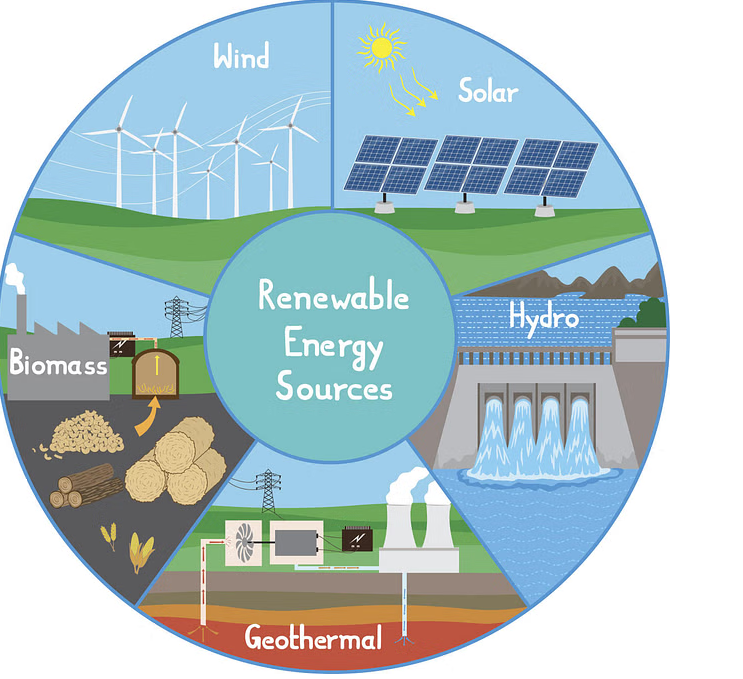Advancing Renewable Energy Technologies: A Comprehensive Analysis

Advancing Renewable Energy Technologies
Renewable energy technologies have emerged
as pivotal solutions in addressing global energy challenges while mitigating
environmental concerns associated with fossil fuel combustion. From solar and
wind power to biomass and geothermal energy, advances in renewable energy
technologies are driving a paradigm shift towards a sustainable energy future.
In this extensive report, we delve into the latest innovations, applications,
challenges, and future prospects of renewable energy technologies.

Renewable Energy Sources
Overview
of Renewable Energy Technologies
Renewable energy technologies encompass a
diverse array of sources and systems, including:
Solar Photovoltaics (PV): Solar PV technology harnesses sunlight to generate electricity through photovoltaic cells. Advances in solar panel efficiency, material science, and manufacturing processes have led to widespread adoption of solar PV systems for residential, commercial, and utility-scale applications.
Wind Power: Wind turbines convert kinetic energy from wind into mechanical power, which is then converted into electricity. Innovations in turbine design, blade technology, and offshore wind farms have significantly increased the efficiency and capacity of wind power generation.
Hydroelectric Power: Hydroelectric dams utilize the kinetic energy of flowing water to generate electricity. Recent developments in small-scale hydroelectric systems, run-of-river turbines, and pumped storage hydropower enhance the flexibility and reliability of hydroelectric power generation.
Biomass and Bioenergy: Biomass energy involves the conversion of organic materials, such as agricultural residues, forestry waste, and biofuels, into heat, electricity, or biofuels. Advances in biomass conversion technologies, including anaerobic digestion, pyrolysis, and bio-refineries, offer renewable alternatives to fossil fuels for heat and power generation.
Geothermal Energy: Geothermal power harnesses heat from the Earth's interior to generate electricity or provide heating and cooling. Enhanced geothermal systems (EGS), geothermal heat pumps, and binary cycle power plants leverage geothermal resources to produce clean, reliable energy with minimal environmental impact.
Recent
Advances in Renewable Energy Technologies
Solar PV Innovations: Recent advancements in solar PV technology include the development of perovskite solar cells, tandem solar cells, and bifacial solar panels. Perovskite solar cells exhibit high efficiency and low production costs, while tandem solar cells combine multiple semiconductor materials to enhance light absorption and power conversion efficiency. Bifacial solar panels capture sunlight from both sides, increasing energy yield and versatility in installation.
Wind Turbine Technology: Next-generation wind turbines feature larger rotor diameters, taller towers, and advanced control systems to optimize energy capture and reduce operational costs. Offshore wind farms, equipped with floating turbines and deep-water installations, harness stronger and more consistent wind speeds, unlocking vast renewable energy potential in offshore environments.
Hydroelectric Innovations: Innovative hydroelectric technologies, such as run-of-river turbines, fish-friendly turbines, and modular hydrokinetic systems, minimize environmental impact while maximizing energy production. Pumped storage hydropower projects, utilizing surplus electricity to pump water uphill for later release during peak demand periods, enhance grid stability and renewable energy integration.
Bioenergy Advancements: Advances in bioenergy include the development of advanced biofuels, biogas production from organic waste, and bioenergy with carbon capture and storage (BECCS) technologies. Advanced biofuels, such as cellulosic ethanol and algae-based biofuels, offer cleaner alternatives to conventional fossil fuels, while BECCS systems mitigate greenhouse gas emissions by capturing and sequestering CO2 from biomass combustion.
Geothermal Innovations: Enhanced geothermal systems (EGS) leverage hydraulic fracturing and reservoir engineering techniques to access geothermal resources in regions with low natural permeability. Advanced geothermal heat pumps (GHPs) utilize ground-source heat exchangers to provide efficient heating and cooling for residential and commercial buildings, reducing energy consumption and carbon emissions.
Challenges and Future Directions
Despite significant progress, renewable
energy technologies face several challenges on the path towards widespread
adoption:
Intermittency and Grid Integration: The intermittent nature of renewable energy sources, such as solar and wind power, poses challenges for grid stability and energy supply reliability. Advances in energy storage, smart grid technologies, and demand-side management are essential for integrating variable renewable energy sources into the grid and balancing supply and demand in real-time.
Cost Competitiveness: While the cost of renewable energy technologies has declined significantly in recent years, achieving cost competitiveness with fossil fuels remains a challenge in certain regions. Continued research and development efforts, coupled with supportive policies such as tax incentives and renewable energy mandates, are needed to drive down costs and accelerate the transition to renewable energy sources.
Infrastructure and Resource Constraints: The deployment of renewable energy technologies requires significant infrastructure investment, including transmission lines, energy storage facilities, and manufacturing capacity. Addressing infrastructure constraints and resource availability, such as land use conflicts, water availability, and material supply chains, is critical for scaling up renewable energy deployment and overcoming logistical barriers.
Policy and Regulatory Uncertainty: Inconsistent policy frameworks, regulatory barriers, and political uncertainty can hinder investment in renewable energy projects and slow down deployment efforts. Clear and stable policy signals, coupled with long-term planning and international cooperation, are essential for creating a conducive environment for renewable energy investment and innovation.
Environmental and Social Impacts: While renewable energy technologies offer significant environmental benefits compared to fossil fuels, they can also have adverse environmental and social impacts, such as habitat disruption, land use change, and conflicts over resource allocation. Implementing sustainable siting practices, stakeholder engagement processes, and environmental impact assessments can help mitigate these impacts and ensure the sustainable development of renewable energy projects.
Editor’s
Thoughts:
Advances in renewable energy technologies
hold the promise of transforming the global energy landscape, reducing
greenhouse gas emissions, and mitigating the impacts of climate change. From
solar and wind power to biomass and geothermal energy, innovations in renewable
energy technologies are driving a transition towards a more sustainable, resilient,
and decentralized energy system. Overcoming challenges related to
intermittency, cost competitiveness, infrastructure constraints, policy
uncertainty, and environmental impacts will require concerted efforts from
governments, industry stakeholders, and research institutions. By harnessing
the full potential of renewable energy technologies and accelerating their
deployment on a global scale, we can build a cleaner, greener, and more
prosperous future for generations to come.